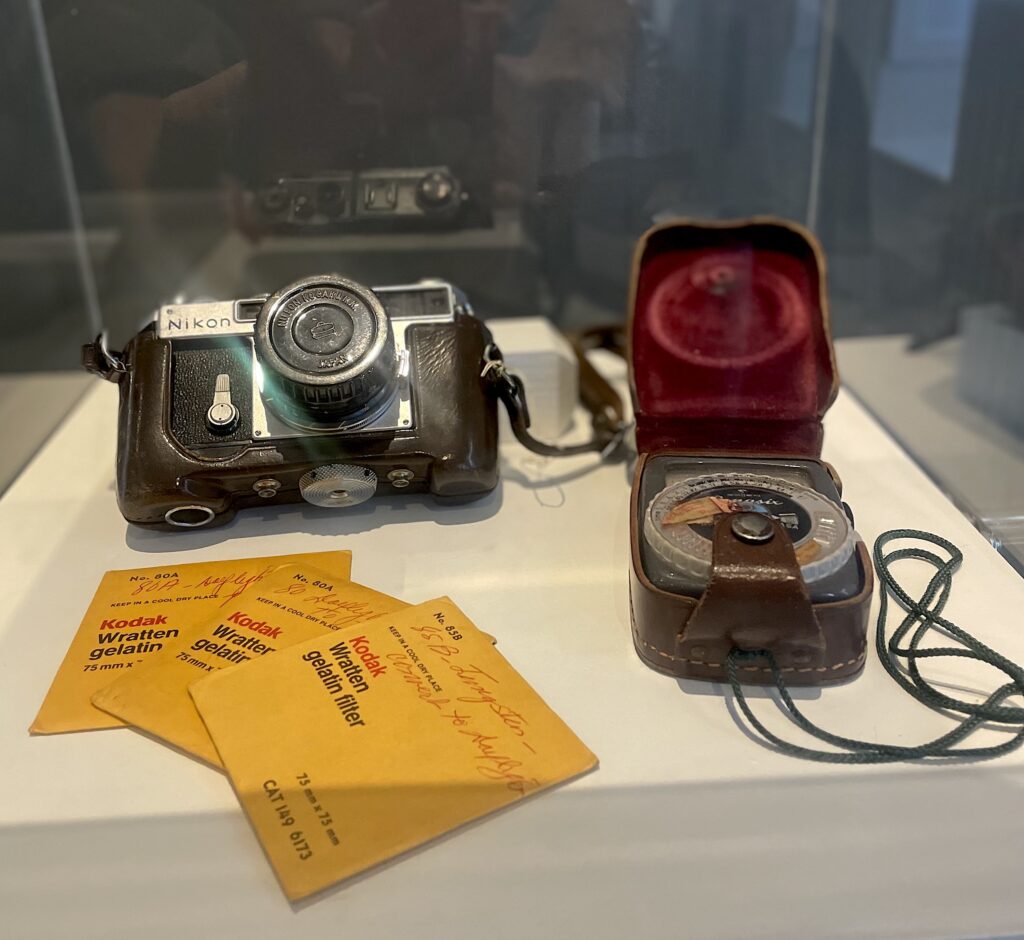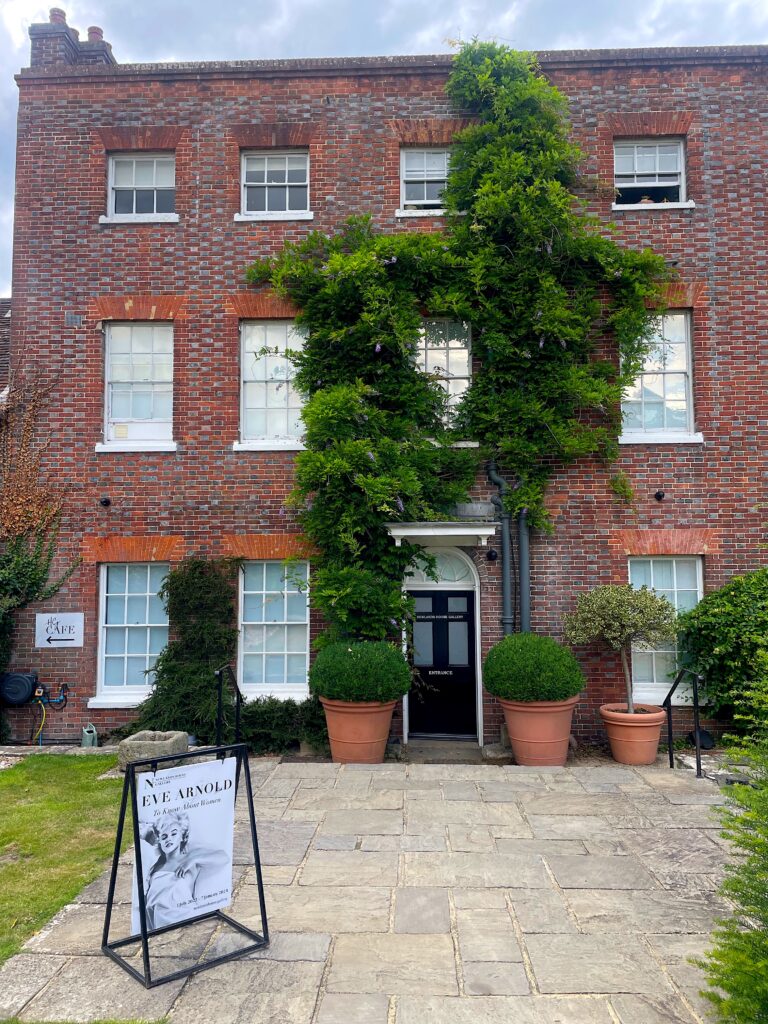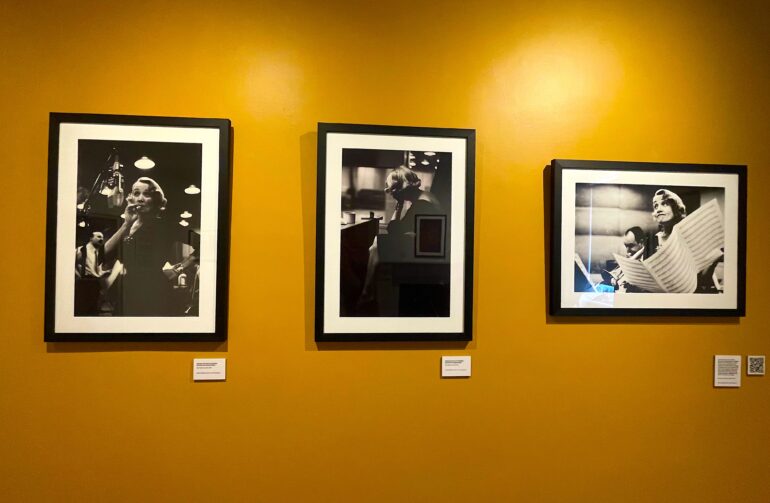Culturalee visited Newlands House Gallery in West Sussex, to review ‘Eve Arnold: To Know About Women’, the first UK retrospective in a decade of one of the most respected women photographers in history, Newlands House is a beautiful 18th Century building located in the picturesque village of Petworth. Since the establishment of a gallery in 2019, Newlands House has staged several critically-acclaimed exhibitions of world-class 20th and 21st Century artists and photographers including; Lee Miller and Picasso, Frank Auerbach, Sean Scully, and more recently contemporary art power couple Annie Morris and Idris Khan.

More than 90 black-and-white and colour photographs are featured in the Eve Arnold retrospective, including her early documentary-style photography capturing fashion shows in Harlem, and iconic images of Marilyn Monroe, the screen legend Arnold documented for many years until her untimely death. Some of the photographs are on display for the first time in 70 years.
Eve Arnold was born in 1912 in Philadelphia and went on to become a world-class photojournalist and favourite photographer of many iconic cultural and political figures including Marlene Dietrich, Jackie Kennedy, Sophia Loren, Elizabeth Taylor, Queen Elizabeth II and most famously, Marilyn Monroe. Arnold was one of only two women to join Magnum Photos, the photographic agency set up in 1947 by legendary photojournalists Henri Cartier-Bresson, Robert Capa, George Rodger and David Seymour.
Arnold was Monroe’s photographer of choice for over a decade and became a friend and trusted confidante. This trust and friendship led to some of the most iconic images of the actress, in particular the series of photos Arnold took on the set of ‘The Misfits’ in 1950, which was to be her last film before her tragic death the following year. The images Arnold took of Monroe on the set of ‘The Misfits’ in the Nevada desert became legendary, and even more poignant when Monroe died at such a young age.

Arnold gained the trust of her subjects, befriending them and forming a circle of trust, which enabled her to capture unguarded, natural images. She learned early on not to click the shutter and to keep the camera in the background, as she realised that as soon as the subject knew there was a camera there, they played up to it.
Her first celebrity portraits were of Marlene Dietrich. Arnold photographed a recording session with Dietrich at Columbia Records in New York in 1952 and avoided ‘clicking’ the camera shutter during the recording so that she could capture the moment, leading to intimate, behind the scenes images of the artist at work, which were revolutionary at a time when Hollywood was so controlling over the images that the public saw of its stars.
A shining example of capturing an unguarded, natural moment, is Arnold’s beautiful portrait of Elizabeth Taylor with Richard Burton, taken in a pub after shooting, with Taylor gazing into the distance and lit like a Madonna, with an incongruous packet of uncooked sausages on the pub counter in front of her, which it is said the chef at her luxury hotel cooked for her later that evening.
Arnold said of the shoot with Dietrich: “I also grew up with Hollywood Movies. Although I was a reluctant host to their imagery, I could not deny their impact on me and on other women. They affected the way we saw ourselves and the way men saw us. The traditional still photograph was an idealized portrait The subject was posed in the most flattering position, and the features were lit – eyes, lips, teeth, cheekbones, breasts, and in Dietrich’s case, legs – like so many commodities. Wrinkles and blemishes were removed by the retoucher. Everything that life had deposited was pencilled out.”
Arnold’s skill was in capturing the essence of her subjects in natural, off-guard moments, enabled by her empathy as a woman and her ability to form trust and friendship with her sitters. Arnold was introduced to Marilyn Monroe by film director John Huston at a party. Monroe had seen Arnold’s portraits of Dietrich in Esquire magazine and said to Arnold: “If you could do that well with Marlene, can you imagine what you can do with me?” This initial conversation sparked a 10-year working relationship and friendship between the two, which resulted in some of the most famous images of Monroe that still live in the popular imagination today.
A curated selection of the captivating photographs documenting filming of ‘The Misfits’ are on display at Newlands House, as well as less well-known series by Eve Arnold which document a wide range of themes including; social history, birth, celebrity, racial inequality and politics. Standout images include Arnold’s photographs of the Nation of Islam rallies and meetings led by human rights and Black empowerment activist Malcolm X in the 1960s.
Arnold’s photographs of the Malcolm X earned Arnold worldwide acclaim as a photojournalist, and one of the most disturbing images on display at Newlands House is a chilling photograph of American Nazi Party leader George Lincoln Rockwell, sitting amongst the black audience listening to Malcom X speak. The American Nazis were an unlikely ally of Nation of Islam, who shared a vision of a racially divided America. Malcolm X later rejected the Nation of Islam, embracing the civil rights movement, meeting a tragic end in 1965 when two Nation of Islam members assassinated him.
Exhibition curator Maya Binkin explains: “Eve Arnold’s photographs of Marilyn Monroe are perhaps her most recognisable images but, in this show, we wanted to focus on the photos she took during some of the defining moments of modern American and social history. Arnold’s empathy for her subjects and her intellect meant she knew how to be in the right place, at the right time, and with a camera in her hand.”
Although the exhibition features exquisitely lit, atmospheric photographs of celebrated actresses including Monroe, Taylor, Dietrich and Isabella Rossellini, the curation also pays homage to Arnold’s interest in marginalised communities, society and politics, and the pivotal role she played through her photojournalism in shining a light on previously undocumented topics such as the civil rights movement of the 1960s in America, same sex marriage in the UK (“Lesbian Wedding celebration, Clapham Common, London, 1965), child potato pickers in Long Island, and veiled women living in Afghanistan and the UAE in the 1960 and 1970s.
Arnold’s parents were Jewish immigrants from Ukraine who had fled to the USA, changing their name from Sklarski and Laschiner to Cohen so that they might fit in better, and as one of 10 children she had grown up in poverty. So perhaps this difficult start in life was a motivation to document the lives of marginalised, under-represented or undervalued people and communities.
Curated in rooms with themes such as ‘The Harlem Images’, ‘Birth’, ‘Celebrity’ and ‘Behind the Veil’, the exhibition culminates in a room themed around ‘Travel’, where images taken by Arnold during her travels in Hinterland China are displayed, which led to her first major solo show exhibition at the Brooklyn Museum in 1980.
Arnold developed an interest in photography whilst working at a Kodak processing factory in New Jersey, and in 1950 she signed up for a 6-week photography course in Manhattan led by Harper’s Bazaar Art Director Alexey Brodovitch. Brodovitch set his students a fashion assignment, and Arnold took an unconventional path by photographing the undocumented world of fashion shows which were held in Harlem every weekend. The resulting photographs caught the eye of Brodovitch, who mentored her and encouraged her to spend more time documenting the scene in Harlem. Arnold was fully committed to immersing herself in the assignment, and her photographs constituted a new form of fashion photography which veered into photojournalism.

Curator Maya Binkin explains: “She spent over a year in Harlem visiting the shows, bars, churches and restaurants every weekend to get to know the community. She learned how to develop professional relationships, how to be present but not visible, and how to assemble a visual storyline. It was only 40 forty years later, when reflecting on the shoots, that she fully grasped what it was that she had achieved. It was a time when the fashion world ignored black people. The clothes were made by local seamstresses or, at times, by the models themselves. The beauty industry was a white concern, or at least that was how it was viewed. She had borne witness to a whole part of the city…She broke away from the fashion studio shoots and produced something that was genuinely fresh.”
The images were controversial at a time when racism was commonplace, and black and white communities didn’t mix, and consequently Arnold tried but failed to get any American magazine to publish them. Picture Post in the UK ended up publishing the images, but this backfired as they wrote copy which was racist in tone, which led to Arnold vowing from then on to write her own copy and maintain control of her images. However, the images caught the attention of the Magnum photo agency in 1951, and at the age of 45 she joined Magnum Photos. The agency protected the work of its photographers by ensuring they retained rights to their images, and Magnum eventually managed to change copyright laws so that photographers got repeat fees for their images. Later on in her career, in 1980, the American Society of Magazine Photographers awarded Arnold with a Lifetime Achievement Award.
Arnold’s images were imbued with a female eye, such as the ‘A Baby’s Momentous First Five Minutes’ series of photos she took in the natal ward of Port Jefferson hospital in Long Island in 1959. Uncomfortably up close and personal for the sensibilities of the 1950s, they proved controversial to some, but carried a deep personal meaning for Arnold since she had personally suffered miscarriage and a hysterectomy. Her image of a Mother’s hand clutching the tiny finger of her new-born baby became a classic advertising image, which was used to advertise everything from breakfast cereal to life insurance.
Surprisingly given the status of Eve Arnold as an internationally acclaimed photojournalist and master of portrait photography, the Newlands House show is the first UK retrospective of Eve Arnold’s for a decade. I asked Maya Binkin, the curator of the exhibition, why a photographer of Arnold’s stature hasn’t had more recognition in the UK in terms of museum shows, especially since she spent a large part of her life in the UK, and she commented:
“Photography doesn’t always receive as much space as it should, especially photojournalism. I know that Eve advocated for a museum of photography in London. I bet she would have been delighted with the newly restored National Portrait Gallery! I think there are many contributing factors as to why she isn’t more of a household name. I hope my show will help correct that. Eve Arnold was a pioneer photographer. She changed fashion photography and helped define photojournalism alongside the forefathers of the medium. She should be a household name just as much as her colleagues, for example Robert Capa and Henri Cartier-Bresson.”
Maya Binkin also curated the acclaimed Lee Miller and Picasso exhibition at Newlands House. Like Eve Arnold, Lee Miller was a formidable woman who made a name for herself as a war reporter and photojournalist, and also crossed over into fine art and fashion photography, but whose oeuvre was often overshadowed by the achievements of her male contemporaries. Binkin collaborated closely with Eve Arnold’s family on the exhibition, and her grandson Michael is giving a talk at the gallery with stories about some of her most iconic images and an insight into her photographic technique.
Binkin explains: “I always try and involve the estates in exhibitions. More often than not, they have great insight and a different point of view than the art historians – a personal one that makes the artist seem more human and relatable. I was very grateful for their help. We were looking to do a photography show following the success of my Lee Miller and Picasso exhibition. We explored many avenues but nothing seemed to tick all the boxes as well as Eve Arnold’s story. She was a force of nature. I hope we have done her justice in this exhibition.”
This retrospective of Eve Arnold’s pioneering photography re-evaluates her oeuvre and demonstrates what a pioneer she was in her creative vision, her passion for representing marginalised people and cultures, and her fearless approach to documenting taboo subjects such as childbirth. Not only was she an accomplished photojournalist, she also pioneered a new way of capturing celebrity which gave an insight into the world of movie stars, breaking out of the mould of heavily retouched Hollywood studio portraits of actors, and paving the way for the a new form of portraiture.
‘Eve Arnold – To Know About Women’, is on until 7th January, 2024 at Newlands House Gallery, Newlands House, Pound Street, Petworth,West Sussex: https://newlandshouse.gallery/exhibitions/eve-arnold-to-know-about-women/



